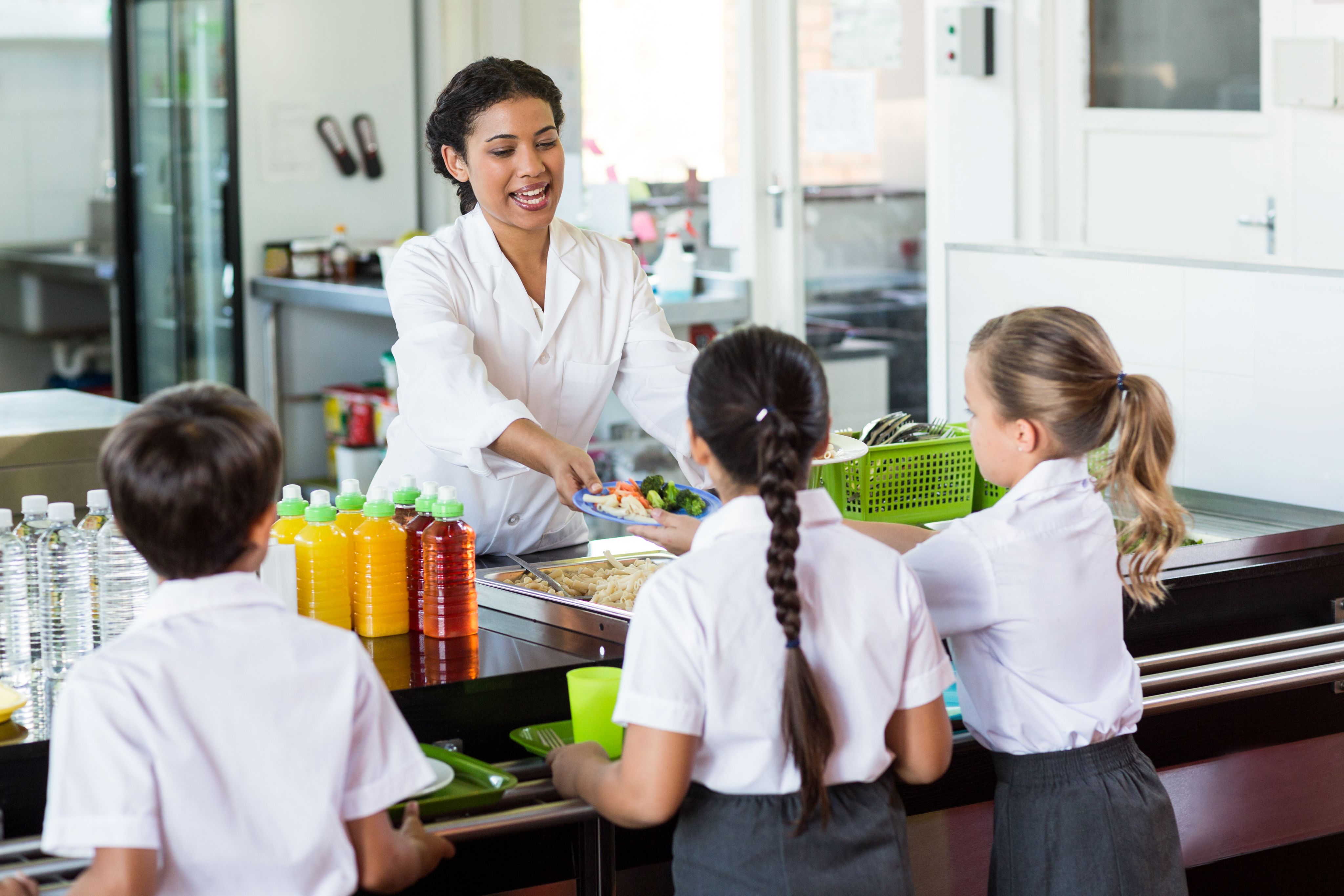School meal system
Mapping the school meal system in Wales

At Nesta we think school food could play an important role in tackling obesity in Wales. Food eaten during the school day makes up a significant part of primary school children's diets; around 17% of meals and snacks they eat.
With free school meals being rolled out to all primary school children in Wales it's more important than ever that these meals are made as healthy as possible.
While it is possible to make small but worthwhile improvements to the healthiness of school food through individual targeted changes, such as the addition of salad bars, the biggest and most sustainable improvements will likely come from larger-scale systems change.
Why are we mapping?
We have begun mapping the stakeholders, activities and connections that make up a typical primary school meal system in Wales. We recognise that this a different school meal system to other parts of the UK. This map will help us:
- identify where we might be able to most effectively intervene in the current system to make positive changes
- understand who we need to involve when we do intervene in any given part of the system
- consider how interventions aimed at one part of the system might impact relationships, stakeholders and outcomes.

Our map so far...
The map is a ‘work in progress’ and we are keen to hear feedback from anyone involved in the planning or delivery of school meals in Wales on how the map might be improved.
The icons on the map represent stakeholders, the boxes denote the activities they undertake and factors that influence the decisions they make. The arrows represent the flow of information and interdependencies of the actions.
The map is a simplified representation of the primary school meal system in Wales. There will be variations from council to council and school to school and the map attempts to demonstrate what a typical system looks like. Similarly the stakeholders represented are responsible for doing many things to support children's health. This map focuses on a few of the most important activities for the delivery of primary school meals in Wales for the 20 councils that manage and deliver this service.
Click on the arrow below to view a larger version or download it as a PDF.

School meal nutritional standards and requirements
The Welsh Government is responsible for setting regulation on school food standards for Wales, which are developed with support from Public Health Wales.
The Welsh Government is also responsible for allocating funding to councils for the provision of free school meals and for ensuring local authorities comply with the school food standards.
School meal compliance
The Welsh Local Government Association (WLGA) hosts the Food in Schools Programme Coordinator who offers support and advice on behalf of the Welsh Government and oversees the voluntary Certificate of Compliance Scheme.
As part of school inspections, ESTYN (Education and training inspectorate for Wales) reports on arrangements made to promote healthy eating.
Through a combination of systems and partnership working, evidence gathering and supporting legislation, Public Health Wales aims to enable children’s health and reduce overweight and obesity. It delivers the Welsh Network of Healthy School Schemes, assisting schools in planning and delivering effective programmes of health education and run the National Quality Awards, which include criteria related to the food offered in schools.
School meal operations at council level
LACA is a membership organisation that represents the school catering sector’s interests. Through its membership it provides support on skill development, guidance, lobbying and campaigning to council catering teams.
The council's catering team is responsible for planning and management of school meals and delivering them through in-school catering teams they manage. This involves a large number of tasks including: procurement of food and equipment from suppliers; menu planning; portion control; staff recruitment and development; auditing schools for food safety and compliance; tracking food purchase orders and wastage; forecasting school meal demand.
School meal operations at council level
The council's catering team creates an approved list of products from suppliers or procurement frameworks (eg, TUCO, ESPO, YPO) through which in-school catering teams are able to place food purchase orders.
School menus, which are carefully designed to meet nutritional standards, are collated into a central recipe list which is shared through a digital platform or by email with school catering teams along with a master list of products needed to create the meals.
School meal delivery at school level
The school catering teams are employed by the council but work within schools’ kitchens. They are responsible for ordering products they need from the suppliers, preparing food from the menu and serving the meals to children.
Within the wider school, the school management team, including the senior management team and the headteacher, are responsible for sharing information with parents about the school meal service, setting the length of lunchtimes and other lunchtime rules. They also make sure the dining hall is properly staffed and equipped – eg, with tables and chairs – and is well decorated.
School meal dining experience at school level
Dining room supervisors oversee the children as they eat their school meals or packed lunches. They play a role in making sure children eat enough of and a variety of foods on their plate, as well as controlling noise and behaviour, making sure the hall is kept tidy and food waste is properly disposed of.
What food and how much of it children decide to eat is driven by a number of factors including their own food preferences or dietary requirements, as well as the wider dining experience. This experience includes how much time they are given to eat, the behaviour of other pupils and a desire to sit with and leave the table to play with their friends at the same time.
In some schools children can give feedback about their school meal experience through the School Council or School Nutrition Action Group (SNAG) — a working group consisting of children, school catering staff and school staff. This group will review the school's food culture and create action plans to improve it. However, this system is not very common and children who are not happy with the experience are more likely to simply decide against eating a school meal altogether.
The decision of whether a child should eat a school meal or opt for a packed lunch is typically made through deliberation between children and their parents or carers — often while surveying the online menus for the week ahead. Parents are influenced by a wide variety of factors including: prior experience, knowledge and perceptions of the current school meal offer, cultural (un)familiarity of food being served and the cost of the meal.
Parents typically order and pay through a dedicated online payment system or through the council's website. When placing an order they are normally given a choice as to what their child would like to eat. This information is used by the school catering team to ensure they have enough stock and prepare enough of each meal on any given day.
While most councils have an email address allowing parents to give feedback on the school food experience, and there may also be opportunities to give feedback via a Parents Teacher Association (PTA), awareness and use of these channels amongst parents is low.
What has this map taught us so far?
1. No one stakeholder can improve primary school food on their own
As we started mapping the primary school meal system, it became clear that this is a complex space, with lots of stakeholders working together to get a plate of food in front of every primary school child that requests one. So making substantial improvements to the healthiness of the food will require stakeholders to work collaboratively and consider how their actions might impact other parts of the system.
2. We need better ways to engage parents and children
From a health perspective it is important to engage parents and children in school meals for a couple of reasons.
We know that school meals are typically healthier than packed lunches. Better sharing of information about and ‘selling’ of the school food offer — including changing parents' often false perspectives on what school food looks like — could encourage parents and their children to shift from packed lunches to school meals, potentially bringing substantial health benefits.
Better channels for feedback (and even co-design) could help schools, councils and others understand how they can improve the food and dining hall experience. This type of insight could increase take up of school meals and encourage children to spend more time eating and so waste less of their school meals (especially the healthier parts of the meal), potentially reducing unhealthy snacking later in the day.
3. Getting school food standards and requirements right is critical
Food served in schools in Wales must meet a set of nutritional standards and requirements set by the Welsh Government. These standards impact on the whole process, from design of menus to the sizes of portions served.
Stakeholders we spoke to suggested the current standards are in need of updating. It is critical that future iterations of school food standards for Wales are both ambitious and based on the latest evidence, but also leave room for innovation from catering teams to create menus that are healthy and attractive to children.
4. We must inspire and empower school leadership teams
Individual schools have substantial power over the dining hall experience and wider school food culture. A pleasant dining hall experience (eg, where children have time and space to sit down and eat in a well-decorated and relaxed environment) may encourage take-up of school meals (rather than packed lunches) and encourage children to spend more time eating. Giving school children more time to eat has been shown to result in significantly more consumption and less waste of healthy fruits and vegetables.
Developing a healthy school food culture (eg, by providing nutritional educational and hands-on cooking and growing experience) could help improve children's relationship with food for a lifetime. Many schools are already running initiatives to improve food culture; examples of good practice need to be shared and celebrated and guidance and resources provided to help inspire and empower others.
Tell us what you think about the Welsh primary school meal system map
The map published is a work in progress and we’d love to hear from anyone that has any feedback on the map. We want to hear if we've got anything wrong and if there are any variations of the system. We are keen to hear what it tells you about what needs to be done to improve the healthiness of food eaten in our primary schools.
If you have any questions or thoughts you would like to share, please get in touch with Jonathan Bone at jonathan.bone@nesta.org.uk or Geetika Kejriwal at geetika.kejriwal@nesta.org.uk
